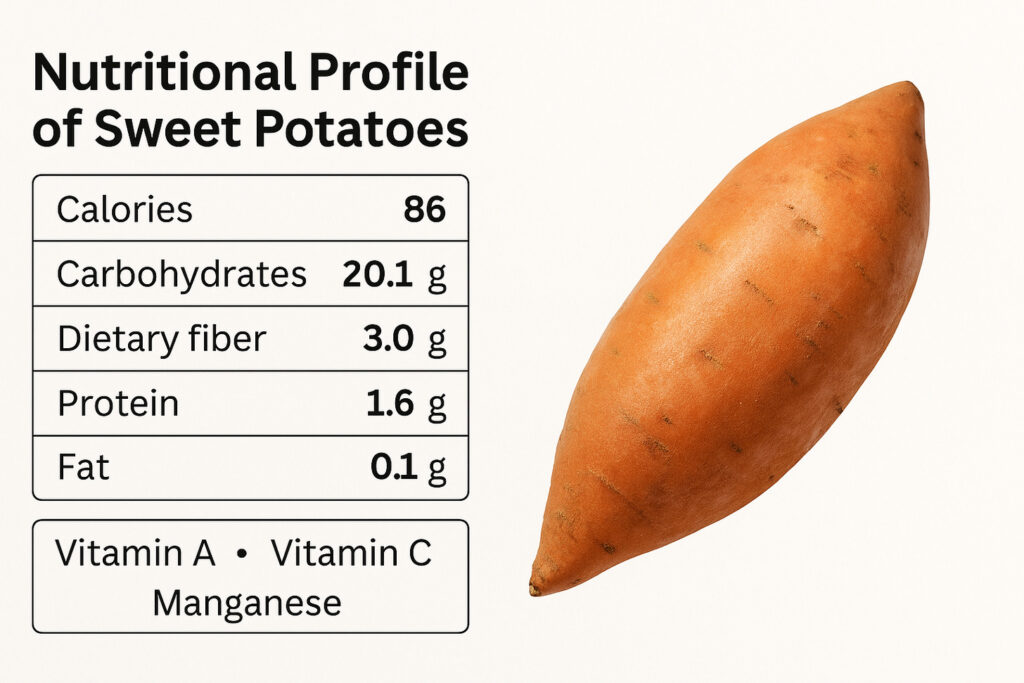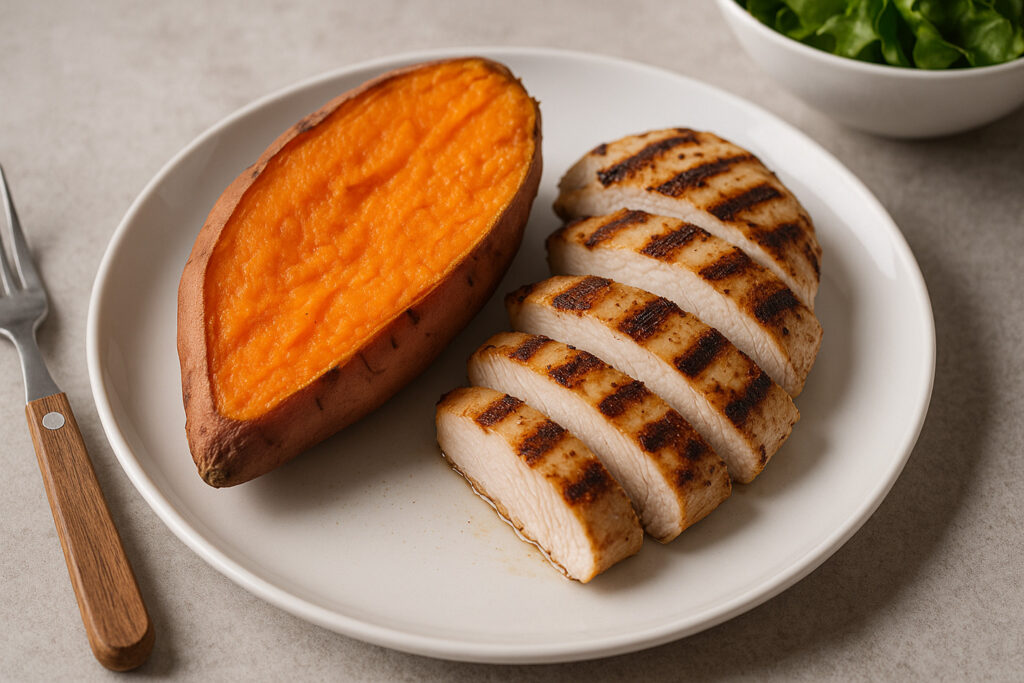Managing carbohydrate intake plays a critical role in stabilizing blood sugar levels. Nutrient-rich tubers like these orange-fleshed vegetables offer fiber, vitamins A and C, and antioxidants. Their natural sweetness doesn’t automatically disqualify them from a balanced eating plan—it’s all about preparation and portion control.
How you cook these root vegetables matters. Boiling or steaming them lowers their glycemic impact compared to roasting or frying. This method helps slow glucose absorption, making them a smarter choice for those monitoring their health. Pairing them with protein or healthy fats further balances their effects.
Though they contain carbohydrates, their glycemic index can remain moderate when prepared thoughtfully. Research shows that mindful consumption supports sustained energy without drastic spikes. Moderation remains key—overeating even healthy carbs can disrupt metabolic balance.
This section explores how to enjoy these versatile ingredients while prioritizing wellness. You’ll discover practical tips for incorporating them into meals without compromising your goals. Let’s dive deeper into strategies that align with evidence-based nutrition for diabetes care.
Understanding Diabetes and Sweet Potatoes
Effective diabetes management hinges on understanding how different foods affect glucose levels. When carbohydrates break down, they directly influence blood sugar, making carb quality and quantity vital. This is where the glycemic index becomes essential—it measures how quickly foods raise glucose compared to pure sugar.
Fiber plays a key role in slowing carbohydrate absorption. This helps prevent rapid glucose spikes, supporting better blood sugar management. Orange-fleshed varieties of this tuber contain soluble fiber, which forms a gel-like substance in your digestive system.
Compared to white varieties, these vibrant roots have a lower glycemic index when prepared properly. Their natural sugars release more gradually due to higher fiber content and beneficial antioxidants like beta-carotene. Steaming or boiling them preserves these advantages better than high-heat methods.
Cooking techniques significantly impact their effect on sugar levels. For example, mashed preparations digest faster than whole roasted pieces. Pairing them with lean proteins or healthy fats further stabilizes energy release.
Portion size remains critical—even nutrient-dense carbs require mindful consumption. A balanced plate with non-starchy vegetables and quality protein creates synergy for sustained metabolic health.
Nutritional Profile of Sweet Potatoes
Packed with essential nutrients, these vibrant tubers deliver more than just energy. Their rich vitamin and mineral content makes them a standout choice for balanced eating. Let’s break down what’s inside and how different varieties offer unique benefits.

Vitamins, Minerals, and Antioxidants
One medium-sized root vegetable provides over 400% of your daily vitamin A needs through beta-carotene. This antioxidant supports eye health and immune function. You’ll also get a part of your daily vitamin C, B6, and potassium—nutrients vital for nerve function and heart health.
Fiber plays a dual role here. It slows digestion to stabilize sugar levels while promoting gut health. Purple varieties add anthocyanins, powerful antioxidants linked to reduced inflammation. These compounds work together to support metabolic balance.
Varieties of Sweet Potatoes in the U.S.
Orange-fleshed types dominate grocery shelves, but don’t overlook other options. Purple-skinned versions contain anthocyanins, while red varieties offer extra iron. Japanese sweet potatoes have yellow flesh and a slightly nutty flavor.
Each type brings distinct nutrients to your plate. Mixing varieties ensures you get a broader range of vitamins and antioxidants. This diversity helps tailor your meals to personal health goals without sacrificing flavor.
Are sweet potatoes ok for diabetics? Debunking Myths
Nutritional debates often cloud the truth about carbohydrate-rich foods. Recent studies confirm that portion size and cooking techniques determine their impact on glucose levels more than the type itself.
Portion Control and Moderation
A half-cup serving provides about 15 grams of carbs—manageable for most people diabetes plans. Pairing this amount with lean protein or healthy fats creates balanced meal synergy. Think sliced pieces alongside grilled chicken rather than a whole baked tuber.

Preparation Methods to Lower Glycemic Impact
Boiling retains nutrients while softening starch structures, slowing sugar release. Steamed versions digest 40% slower than roasted ones, according to 2023 research. These methods help foods work with your metabolism instead of against it.
Mashed preparations spike glucose faster than cubed or whole-cooked servings. For people monitoring intake, texture matters as much as temperature. Cooled versions develop resistant starch, adding another layer of blood sugar protection.
Smart choices let you enjoy these vibrant roots without guilt. Focus on strategic pairing and method selection—your meal plan stays flavorful and functional.
Managing Glycemic Index and Blood Sugar Levels
Balancing energy sources requires knowing how different carbs interact with your system. Two tools help here: glycemic index (GI) measures how quickly food raises glucose, while glycemic load (GL) factors in portion size. Together, they guide smarter dietary decisions without cutting out favorite ingredients.
Understanding Glycemic Index and Glycemic Load
Low-GI options (55 or less) release energy gradually, supporting steady blood sugar. High-GL meals pack more carbs per serving, which can overwhelm insulin response. Pairing medium-GI items with fiber or protein lowers their overall impact.
Cooking Techniques to Manage Blood Sugar
Steaming preserves nutrients while softening starch structures. This method reduces digestibility speed by 30% compared to roasting, according to a 2022 diet study. Spiralizing into noodles adds surface area, slowing sugar absorption further.
Cooling cooked tubers overnight increases resistant starch. This fiber-like compound feeds gut bacteria instead of spiking glucose. Reheating maintains this benefit, making meal prep a powerful tool for metabolic health.
Creative and Healthy Sweet Potato Meal Ideas
Transforming everyday meals into nutritious powerhouses starts with smart ingredient choices. These vibrant roots shine across all meal times when paired thoughtfully with complementary proteins and fats. Let’s explore delicious ways to enjoy their natural sweetness while keeping portions in check.
Breakfast Smoothies and Toasts
Blend cooked tuber cubes into morning smoothies with almond milk and chia seeds. This adds creaminess without spiking sugar levels. For a crunchy twist, slice them thin, toast until crispy, and top with almond butter and pumpkin seeds. These options balance carbs with healthy fats for steady energy.
Lunch and Dinner Recipes
Try stuffed versions filled with ground turkey or black beans for lunch. Baking halves instead of mashing slows glucose release. Keep serving size to half a cup—pair with roasted broccoli or spinach for extra fiber. Sheet-pan dinners with salmon and cubed roots simplify cooking while maximizing nutrients.
Snack and Side Dish Inspirations
Swap regular fries with baked matchsticks dusted with smoked paprika. Their antioxidants remain intact when roasted at lower temps. For sides, mix mashed tubers with Greek yogurt and garlic—this adds protein to counter carb effects. Sprinkle walnuts on top for crunch and insulin-friendly omega-3s.
Expert Tips for Including Sweet Potatoes in a Diabetes-Friendly Diet
Strategic food pairings transform how your body processes carbohydrates. Registered dietitian Marisa Moore emphasizes combining these fiber-rich roots with complementary nutrients to balance energy release. This approach helps maintain steady glucose levels while delivering essential vitamins.
Consulting Nutrition Experts
Holistic health counselor Tracee Yablon Brenner recommends personalized portion guidance. A half-cup serving paired with 3 oz of grilled fish creates a blood sugar-friendly meal. Experts analyze your unique metabolism to adjust cooking methods—like opting for boiled over fried preparations.
Nutritionists often suggest tracking post-meal glucose responses. This data helps refine your intake strategy. For example, cooling cooked tubers overnight increases resistant starch content, which may positively affect blood sugar management.
Combining With Protein Sources
Pair cubed pieces with Greek yogurt or scrambled eggs at breakfast. The protein slows carbohydrate absorption, reducing glucose spikes. For lunch, try roasted slices alongside turkey breast and avocado—healthy fats add another layer of metabolic support.
Evening meals benefit from salmon served over spiralized noodles. This combination provides omega-3s that improve insulin sensitivity. These practical pairings let you enjoy flavorful dishes without compromising health goals.
Conclusion
Making informed choices about carbohydrate sources can enhance your blood sugar management strategy. When prepared thoughtfully and consumed in controlled portions, orange-fleshed root vegetables offer valuable nutrition without compromising metabolic health.
Key takeaways emphasize moderation through measured servings and cooking methods that slow glucose absorption. Pairing these fiber-rich ingredients with proteins or healthy fats creates meals that support sustained energy release.
Creative preparation techniques—like steaming or cooling cooked portions—maximize their nutritional benefits. This approach aligns with evidence-based dietary patterns for effective diabetes management.
Always consult a registered dietitian to tailor intake to your unique needs. Combining scientific guidelines with mindful eating habits lets you enjoy flavorful dishes while prioritizing balanced nutrition.
Remember: Smart substitutions and portion moderation make it possible to eat sweet varieties safely. Your healthcare team can help refine this balance for long-term wellness.
FAQ
How do sweet potatoes affect blood glucose compared to white potatoes?
Sweet potatoes have a lower glycemic index than white potatoes due to higher fiber content, which slows sugar absorption. Choosing varieties like Garnet or Jewel and moderating portions can help manage blood sugar spikes.
What nutrients in sweet potatoes support metabolic health?
They’re rich in dietary fiber, vitamin A, and antioxidants like beta-carotene. These nutrients aid insulin sensitivity, reduce inflammation, and promote steady glucose metabolism when consumed as part of a balanced diet.
Can cooking methods change how sweet potatoes impact blood sugar?
Yes. Boiling or roasting with the skin intact retains more fiber, lowering the glycemic response. Avoid sugary toppings—opt for olive oil, cinnamon, or protein sources like Greek yogurt to balance meals.
How much sweet potato is safe to eat with diabetes?
A ½-cup serving of cooked sweet potato is a typical portion. Pair it with lean proteins or healthy fats to further stabilize energy levels. Consult a dietitian to personalize intake based on your carb goals.
Are there specific sweet potato varieties better for glycemic control?
Purple sweet potatoes contain anthocyanins, antioxidants linked to improved insulin regulation. However, all varieties can fit into a diabetes-friendly diet when prepared thoughtfully and consumed in moderation.
Should sweet potatoes replace other carbs in a diabetic meal plan?
They’re a nutrient-dense alternative to refined grains or sugary snacks. Swap white rice or pasta with mashed sweet potatoes, but always monitor total carbohydrate intake to avoid exceeding daily limits.


